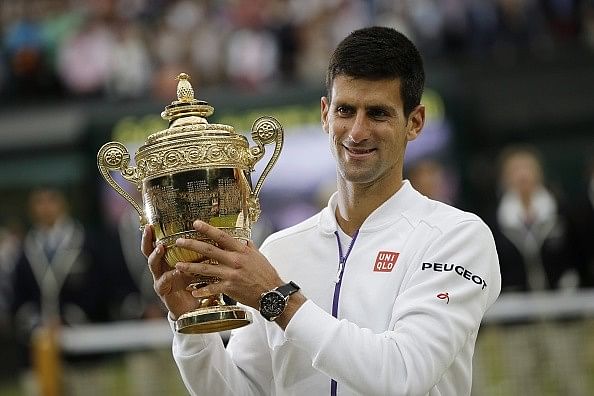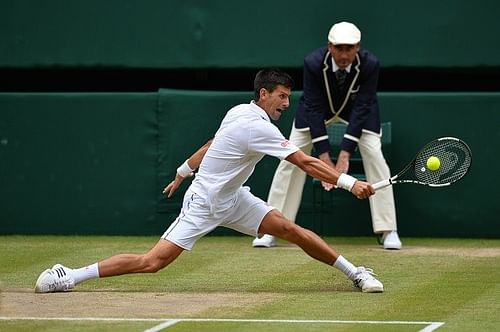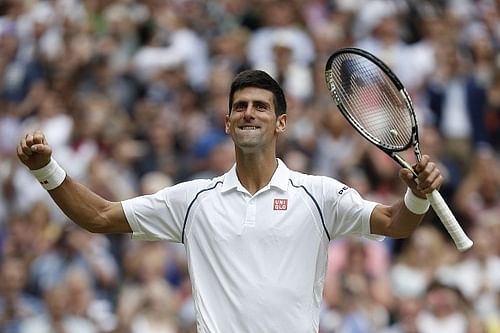
Novak Djokovic and the art of winning

When Novak Djokovic sent down a forehand crosscourt to seal Roger Federer’s fate in Sunday’s final, he let out a celebratory roar that declared to the world that his defeat of the Swiss master the previous year was no fluke.
The Serb epitomizes the evolution that the game has witnessed since the advent of the Open Era. As the racquets, balls and surfaces changed, the players did too. They are now more athletic and possess far more physical strength when compared to the players in the 70s or 80s.
The modern day tennis player is a testament to the Olympic motto - “Faster, Higher, Stronger”. They cover more ground, possess the agility and speed of a gazelle and practically take the hide off the ball each time they strike it with all their ferocity.
With world class players being churned out in academies across the world, there is no dearth of emerging players. And with the new order constantly challenging the Big 4, upsets are no longer surprising. Amidst the churn, there are few that hold fort to retain the crown.
Rafael Nadal did that on the Roland Garros clay with 9 titles in 10 years, while Federer ruled the Wimbledon lawns for 5 years from 2003 to 2007. Djokovic seems to have now taken over. And in winning two out of three Grand Slams this year, he certainly has hit a purple patch.
So how exactly does the tenacious Serb manage to do it? At Wimbledon this year, he faced off against some unheralded opponents – normally the ones to cause upsets, and came up on top. And when Kevin Anderson pushed him to the brink of elimination, Djokovic emerged – unruffled and victorious.
The champion is blessed with almost superhuman-like abilities, and attempts to identify chinks in his armour are best left to the John McEnroes of the game. That said, as a fan and admirer, it certainly is worth the effort to call out the abilities that make Djokovic the champion that he has become.
An impregnable defense

At the height of his game during his superlative winning streaks at Roland Garros, Nadal displayed the ability to retrieve everything that was struck at him. Djokovic seems to be doing the same now.
When Kevin Anderson hit ferocious approach shots, the World No. 1 passed him with winners. When Federer tried the occasional drop shot in the final, Djokovic not just retrieved it but struck a winner without breaking a sweat. Arguably one of the best returners of serve, if not the best, the Serb possesses an incredible defensive game.
With tennis mutating into a power game with constant focus on big hitting and winners, Djokovic displays a remarkable ability to nullify his opponents’ brute force. Adding to his defensive arsenal is his superior court coverage. Again, as if to take a leaf out of Nadal’s book, there isn’t a corner on the tennis court that escapes the Djokovic radar.
In the final, Federer had him running to all corners and yet the Serb was there – either hitting back winners or returning consistently to force errors.
Ability to rise to the occasion

The ability to hit an ace when facing a break point made Pete Sampras special. Likewise, the ability to hit a winning return when looking to break serve made Andre Agassi dangerous. Djokovic seems to have absorbed all these tenets from the greats of yesteryears.
Every time Federer looked to push for a break, Djokovic either had an ace up his sleeve or would resort to outplaying the Swiss with penetrative ground strokes.
The ability to stay unruffled under pressure is also one of the things that champions are made of. Djokovic displayed this in ample measure in the match against Anderson. When the inspired South African took a two set lead, Djokovic set himself up for the long haul. Slowly but surely, he clawed back with a fighting ability seldom seen today to eventually outclass the towering Anderson.
Superior stamina and consistency

When Djokovic got the better of Nadal in the 2012 Australian Open final, it was after 5 hours and 53 minutes of grueling tennis. It was but fitting that one of the fittest professionals on tour won that final. As much as power dominates the present day game, Grand Slams are won on the back of superior stamina.
An almost forgotten fact is that it takes two weeks of back-to-back tennis and seven best-of-five matches to win a Grand Slam. More often than not, a player puts in his best only to fade away in the next round. Dustin Brown played the game of his life to get the better of Nadal only to lose to Viktor Troicki two days later.
That Djokovic kept out Anderson in a five-setter that spanned two days and still had enough in the tank to take out Marin Cilic in the quarters, Richard Gasquet in the semis and then Federer in the final while squandering just one set in the process speaks volumes of his stamina and consistency.
Ability to enjoy the game

Videos of Djokovic’s impersonations on YouTube receive millions of hits, and crowds at the Australian Open eagerly await his on-court post-match interviews with Jim Courier.
Djokovic is one of the few players in tennis, from the present and past, to wear a smile in the middle of a game. So engrossed are players at planning the downfall of an opponent that seldom do they seem to be actually enjoying a match. The very fact that they maintain a straight face laced with aggression makes you think that maintaining a tunnel-vison while wearing blinders is the only way to victory in the present day professional game.
But Djokovic proves that it is not be the only approach. When Anderson was powering winners, the Serb nodded and applauded in acknowledgement. And when one of his efforts was nullified by the South African, Djokovic looked up to the stands and smiled as if to say, “There’s nothing much that I could do at that.”
It’s moments like these that indicate the World No. 1 truly enjoys every outing. In the process, he also shows that in this unforgiving world of competitive tennis, you can take a moment to appreciate a good stroke, smile about an error and still end up on top.
The legendary Bjorn Borg once said about the key to success, “You have to find it. No one else can find it for you.” At 28 years of age, Djokovic seems to have unearthed all the ingredients to success. With nine Grand Slams in his kitty, he is already a great champion and destined for more victories in the years to come.
As fans of the man and followers of the game, we can only marvel at his skill and smile at his antics. As for his opponents, they could perhaps take a leaf out of his book as they toil to unseat the champion while decoding the art of winning – the Djokovic way.